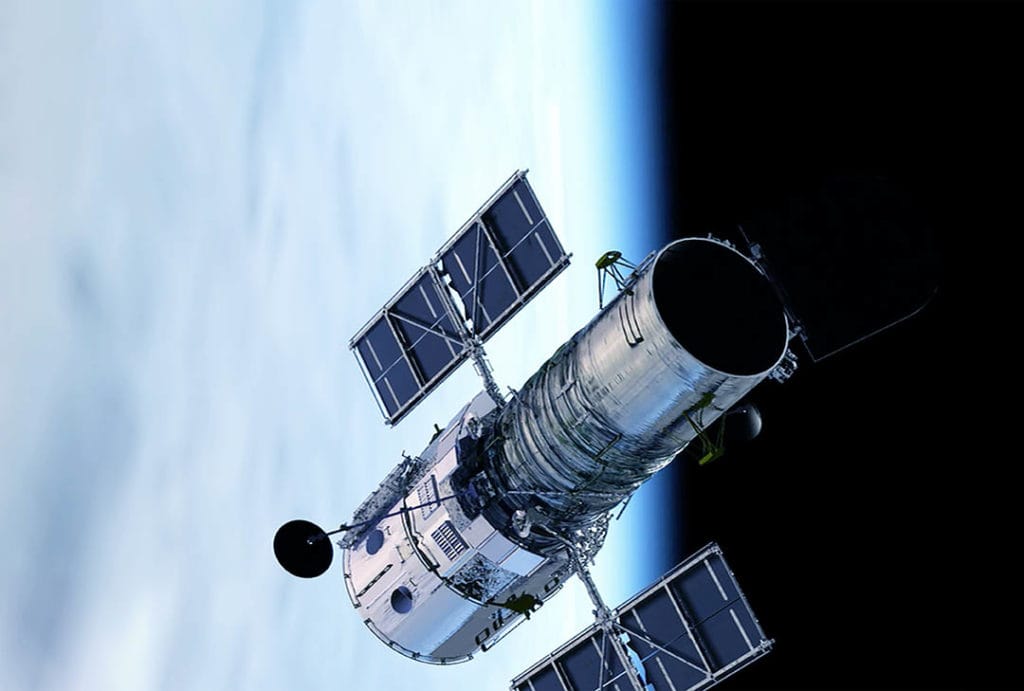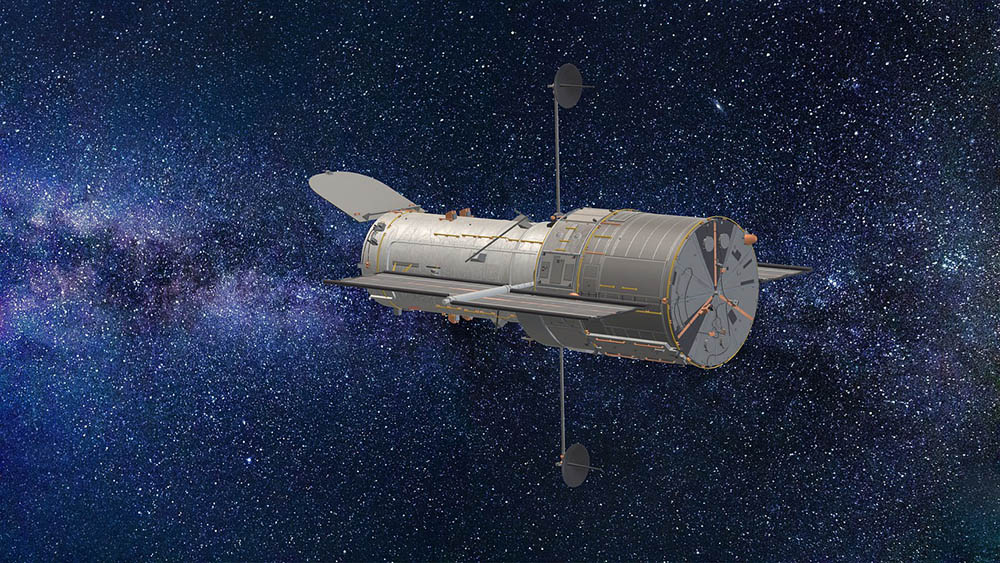10 Interesting Hubble Space Telescope Facts You Never Knew (2024 Updates)
Last Updated on

The Hubble Space Telescope was launched and placed into orbit in 1990 – it is one of the most iconic telescopes ever made and has been used to study the universe in ways impossible for terrestrial telescopes. Here are some amazing facts about this amazing part of American space exploration:

Top 10 Hubble Space Telescope Facts
1. The Hubble Space Telescope was named after a great astronomer
Edwin Powell Hubble was born in 1889 and lived until 1953. He was a famous astronomer and contributed greatly to our understanding of how the universe works. He noted, for example, that what we had seen as distant clouds of light in the sky were actually galaxies, and that the further a galaxy is from earth, the faster it appears to be moving away from our planet. This was a critical piece of the expanding universe theory, which is critical to the “Big Bang” theory of the universe’s beginning.
2. Space telescopes like Hubble can see more clearly than terrestrial telescopes
The Hubble Space telescope can see light that isn’t distorted by Earth’s atmosphere. The atmosphere protects the surface of the earth from light – which is good because it protects life on earth from harmful rays like ultraviolet – but bad because telescopes cannot see stars and other light sources in the universe as clearly. By orbiting outside the Earth’s atmosphere, the Hubble can see ultraviolet clearly and get better information about the heavenly bodies it is watching.
3. The Hubble Space Telescope is a Cassegrain reflecting telescope
Reflecting telescopes are the most common optical telescope used today. They work by reflecting light across multiple mirrors to concentrate it on scientific instruments or imaging components. This allows the telescope to “see” light across a large surface and concentrate it via a specially shaped set of mirrors onto a small focal point.
4. The Hubble Space Telescope is bigger than you think
The Hubble Space Telescope is a little longer than the average school bus (more than 40 feet), is around 14 feet in diameter, and weighs around 27,000 pounds.

5. The Hubble Space Telescope orbits the earth
The Hubble Space Telescope orbits the earth at an altitude of 340 miles and orbits around the planet once every 95 minutes. This is why the Hubble cannot take useful pictures of earth itself. The imagers on the telescope require at least 1 tenth of a second (0.1 seconds) of exposure time to create an image. In this time, the Hubble moves almost half a mile, or 700 meters – that’s 17,000 miles an hour!
6. The Hubble Space Telescope carries advanced science instruments
The Hubble Space Telescope carries several cameras and spectrographs (tools for measuring wavelengths of light) and guidance sensors to help orient it in space. Instruments can be added to and removed from the Hubble. It’s sort of like changing out eyepieces on a telescope at home – each one can do something different, and the Hubble can have multiple “eyepieces” at the same time.
7. There have been 5 missions to service the Hubble Space Telescope
- STS-31 saw the Space Shuttle Endeavor place the telescope in orbit.
- STS-61, fixed an imaging problem the Hubble had with an improperly shaped mirror and several other upgrades.
- STS-82’s primary purpose was to install tools so Hubble could see infrared light.
- STS-103 was a split set of servicing missions to replace failed gyroscopes. Without gyroscopes, Hubble cannot orient itself in space and orbit correctly or stay on target when viewing. This mission set also saw the installation of many hardware upgrades to cameras and computers.
- STS-125, the last servicing mission, was the longest and most difficult and required 5 spacewalks. There were many hardware upgrades made, and the amazing pictures we still see produced by the Hubble today are made using this hardware – installed in 2009!

8. The Hubble Space Telescope uses less data than your Netflix account
Even though it’s designed as a camera and to take amazing pictures, the Hubble Space Telescope only transmits around 19 gigabytes of data to earth each week – or about what you use to watch 8 hours of Netflix.
9. The Hubble Space Telescope is solar powered
In space, solar panels can collect a lot more energy than they can on the surface of the Earth. The Hubble Space Telescope uses six NiH batteries powered by two large solar panels to collect data and send it to earth. To turn, the Hubble telescope does not use thrusters or rockets. Instead, it rotates its wheels in the appropriate direction to change its orientation.
9. The Hubble Space Telescope is extremely precise
The Hubble Space Telescope can track a target so small so well that it would be able to stay pointed at a dime over 200 miles away – of course, the things it takes pictures of are much further than that. The telescope takes photos of things that are 13.4 billion light-years away!

10. The Hubble Space Telescope routinely finds new and exciting things in space
Just this month the Hubble Space Telescope uncovered data that shows what may be the largest comet ever recorded – 50 times larger than average, with a tail 80 miles long!

Conclusion
The Hubble Space Telescope is one of mankind’s greatest achievements in space – and space travel is one of mankind’s greatest achievements of all time. Everything from our conception of what galaxies look like to the discovery of black holes to the Big Bang theory owes their origin to this wonderful piece of equipment. Hubble reminds us that as big as life seems here, it’s quite small compared to the rest of the universe!
Featured Image Credit: Artsiom P, Shutterstock
Table of Contents
- Top 10 Hubble Space Telescope Facts
- 1. The Hubble Space Telescope was named after a great astronomer
- 2. Space telescopes like Hubble can see more clearly than terrestrial telescopes
- 3. The Hubble Space Telescope is a Cassegrain reflecting telescope
- 4. The Hubble Space Telescope is bigger than you think
- 5. The Hubble Space Telescope orbits the earth
- 6. The Hubble Space Telescope carries advanced science instruments
- 7. There have been 5 missions to service the Hubble Space Telescope
- 8. The Hubble Space Telescope uses less data than your Netflix account
- 9. The Hubble Space Telescope is solar powered
- 9. The Hubble Space Telescope is extremely precise
- 10. The Hubble Space Telescope routinely finds new and exciting things in space
- Conclusion
About the Author James Davis
James Davis is a pharmacist, husband, father, homesteader, jack-of-all-trades, and freelance writer. He’s always looking for new ways to make useful knowledge accessible to everyone wanting a better life. Let's learn from what he has to share!
Related Articles:
15 Crucial Facts About Ultraviolet Rays & the Sun
What Constellation Is Spica In? The Interesting Answer!
10 Interesting Leo Constellation Facts, Myths, and FAQs
15 Interesting Pegasus Constellation Facts, Myths, and FAQs
6 Interesting Sagittarius Constellation Facts, Myths, and FAQs in 2024!
What Are Constellations? Where Did They Come From?
8 Interesting Libra Constellation Facts, Myths, and FAQs
What Is Infrared Radiation? Science-Based Facts & FAQ
